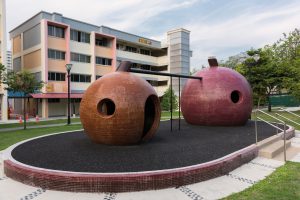Tampines Central: Government-Resident Partnerships at Work
May 23, 2022

The Housing and Development Board (HDB) Community Week is community engagement program usually held in the latter half of May each year. It is part of HDB’s plan to build community-centric towns and strengthen social bonding among residents living in the same community. Activities are held in various HDB neighbourhoods in Singapore. In 2019, some of the activities include the ‘Good Neighbour Award’, ‘Thank-My-Neighbour Note Writing’, and ‘Friends of Our Heartlands’ appreciation ceremony, which recognizes volunteers’ contributions to the community. Additionally, the ‘Silver Fitness and Wellness Carnival’ in Bedok Square held workshops, talks and exhibitions for the elderly and established a Memorandum of Understanding (MOU) with Temasek Polytechnic (TP). The MOU will see students enrolled in TP’s Diploma of Gerontology course engage more regularly with the elderly through HDB community programmes. Lastly, there were outreach campaigns by student volunteers and project SPHERE, and an art and dance performance in the Bedok neighbourhood.
In ‘Tampines Central: Government-Resident Partnerships at Work’ (in Neighbourhoods for the City in Pacific Asia (Amsterdam University Press, 2020)), Associate Professor Ho Kong Chong (NUS Sociology) reflects on his experience as a research consultant for the Tampines Central community engagement project.
This project, headed by Dr Im Sik Cho (NUS School of Design and Environment), was initiated by Singapore’s Housing and Development Board (HDB). The intent was to improve community bonding at housing estates by introducing new amenities. Dr Im and her team consulted residents and improved four locations by increasing residents’ lingering and bonding time.
A/P Ho studied the efficacy of these improvements. Through closed-circuit television (CCTV) cameras, A/P Ho and his team observed the frequency that amenities were used, and the demographics using these amenities. A/P Ho also conducted focus group discussions to find out why different groups of residents used ordinary spaces in various ways.
For instance, at the void deck of a housing building, a storeroom was constructed to house portable chairs and fans at a void deck. This allowed the Residents’ Committee (RC) to convert the void deck into an events location. Events, such as cooking classes, encouraged younger and older residents to convene and interact together. The highly visible environment of a void deck also attracted curious passers-by, and its open structure accommodated any overflow of participants.
A/P Ho stresses the importance of community engagement in neighbourhood improvement projects. The HDB or other statutory boards could have implemented development projects without consulting residents. However, by engaging with the RCs and local residents, government-resident partnerships have the potential to result in more strategic and effective improvement projects.
Read the chapter here.
